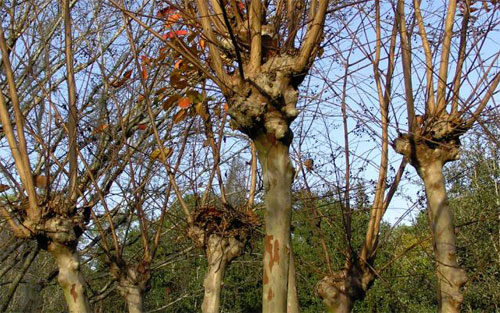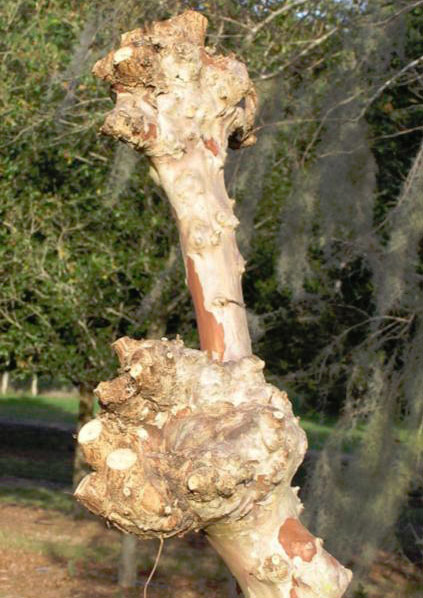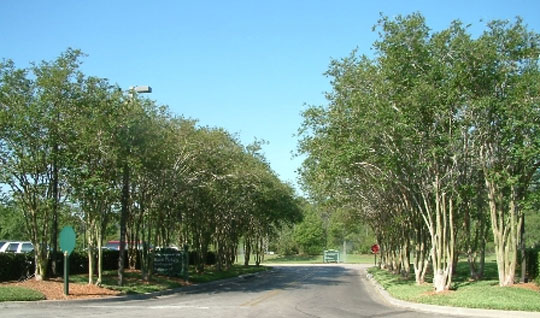Stop Crape Murder: Don’t Cut Back Your Myrtles
January 19, 2020
by the Santa Rosa County Extension Service
Proper pruning is one of the most misunderstood of all gardening practices, yet it is one of the most important procedures in a landscape. A common victim of bad, improper pruning is the crape myrtle. Crape myrtles will occasionally need pruning to obtain the desired landscape effect, but many times these plants are butchered for no good reason.
According to Dan Gill, LSU Ag Center Horticulturist, an unfortunate trend in crape myrtle pruning is to lop off their tops, which results in a tree reduced to large branches ending in stubs. The lush growth that occurs at these cut sites appears vigorous but is actually structurally weak and more susceptible to fungus diseases such as powdery mildew. And when pruning is conducted improperly over several years, unsightly large, swollen knobs form at the point where pruning is done each year.
Flowers are not the only virtue of this tree. Many varieties have beautiful bark and growth habits that can be enjoyed all year if trees are not heavily pruned.
Crape murder
This unsightly, ugly pruning known as crape murder is not recommended. Once it’s done, it ruins the tree’s graceful natural shape for the rest of its life.
Often gardeners think they are supposed to prune their crape myrtles that way, and nothing could be farther from the truth. Many think that crape myrtles need to be cut way back to bloom well. This is not accurate. The flower clusters may be larger on lopped trees, but the added weight on the ends of long branches causes them to bend over awkwardly, especially after it rains. And since the tree is smaller, it actually produces fewer flower clusters.
 Many people say they need to cut a crape myrtle back because of its size. If the height of the crape myrtle is not causing a problem with a nearby structure or power lines, there is little reason to reduce the tree’s height. To cut a crape myrtle back for the vague reason of “it just seems too large” ignores the fact that these plants are trees. They are supposed to be large.
Many people say they need to cut a crape myrtle back because of its size. If the height of the crape myrtle is not causing a problem with a nearby structure or power lines, there is little reason to reduce the tree’s height. To cut a crape myrtle back for the vague reason of “it just seems too large” ignores the fact that these plants are trees. They are supposed to be large.
To prune a crape myrtle properly, first decide if it needs to be pruned. As with any pruning project, you must have a specific, valid purpose in mind before you begin. In other words, if you can’t come up with a good reason to prune your tree – leave it alone. If you do see something that calls for pruning, study the tree carefully and determine what needs to be pruned to accomplish the specific purpose identified.
There are a few valid reasons for pruning a crape myrtle. One reason is to eliminate crossed and rubbing branches because rubbing branches can lead to open wounds.
Over time, branches that are too low on the trunk will need to be pruned to raise the canopy. We often need to remove weak, thin branches from the inner part of the tree to produce a cleaner-looking tree. Selected branches may need to be pruned back to a side branch or the trunk to create a shapelier tree. Of course, you need to prune to keep suckers removed from the base of the trunk.
 Generally, avoid cutting back or shortening branches much larger than your finger, although cutting larger branches back to a side branch or to the trunk when needed is fine.
Generally, avoid cutting back or shortening branches much larger than your finger, although cutting larger branches back to a side branch or to the trunk when needed is fine.
Visitors to our area often marvel over our crape myrtles. During summer, their colorful flowers, attractive bark and beautiful shape make them among our most valuable landscape plants. Please appreciate this – and stop the unfortunate trend of hacking them back.
Pictured top: Crape myrtle trees do not need pruning for new growth. Pictured below: These Crape myrtles were ruined with unnecessary topping. Submitted photos for NorthEscambia.com.
Comments
7 Responses to “Stop Crape Murder: Don’t Cut Back Your Myrtles”





Anyone know how to actually murder one. I have one I need gone. Im worried about the roots and my septic.
I am officially forming an advocacy group for plant s rights. They can t speak, so I m going to speak for them. My first mission to stop Crape Murder!
I have noticed hummingbirds around my red crepe myrtle. I am fairly certain that they were finding small insects because the flower doesn’t appear to have a lot of nectar. Crepe myrtles are beautiful when the gulf coast gets extremely hot in the middle of the summer. They are much easier to control spread than the popcorn trees.
Even though they make pretty flowers for a short time. They are VERY evasive and almost impossible to kill.
I snatched a tree that was about the size of the big end of a softball bat 20 years ago, its still spouting up from the roots that remained.
I rather plant a tree that produces something edible or better shade.
The pruning part, well its not gonna kill it, and the less plant the better. Almost as bad as the popcorn tree..
Can’t kill those things!!!
Mine have grown so tall and are in the power lines. If I do not cut them back then the power company most certainly will and it will not be pretty! I hate to do it but it is a must!
It may not be recommended, but a joint decision to perform a “Crepe Murder” was made in October last year. And at some point this winter, my crepe myrtles will be cut back for the first time in 15 years. I anticipate them looking similar to the trees in the bottom pic of the article. Once cut, they will once again be allowed to grow wild until the next owner of the house decides to conduct their own “crepe murder”.
And if I have the misfortune to actually kill my tree trees, well, that area of the yard is going to look just find with some additional St Augustine grass to fill the new bare spots.